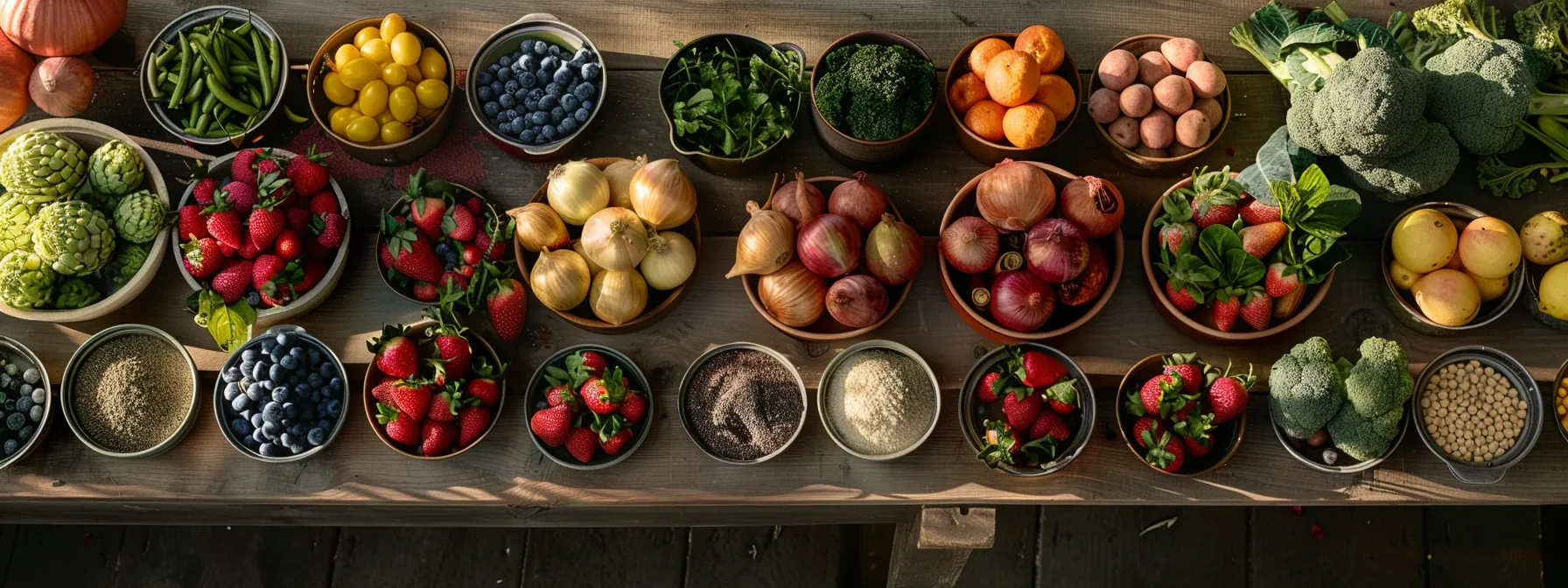Choose Whole Foods Over Processed Foods for Optimal Health
Navigating the landscape of a healthy diet, many find that choosing whole foods over their processed counterparts serves as a form of therapy for the body. Consulting with a physician often leads to the advice that whole foods are packed with necessary nutrients, devoid of excess salt, and instrumental in weight management. Incorporating a variety of vegetables and fruits into your meals not only nourishes you but also promotes a sense of wellbeing. To truly understand how a shift towards whole foods can enrich your life, it’s vital to delve into the evidence linking natural ingredients to lasting health benefits. In this article, we’ll unravel the advantages of whole foods and offer practical advice on integrating them into your daily routine.
Understanding the Impact of Whole Foods on Health

Evaluating my journey toward better health, I’ve recognized that integrating whole foods into my diet serves as a foundation for nourishment and wellbeing. Whole foods are those that remain close to their natural state, offering a cornucopia of benefits, from nutrients to fiber, without the excessive saturated fat found in their processed counterparts. These foods, like a vibrant chickpea salad dressed in its simplicity, contribute substantially to our daily nutritional intake, ensuring our bodies receive a varied and dense spectrum of vitamins and minerals. In stark contrast, processed foods often undergo significant refinement, stripping away much of their original goodness, leaving behind additives that may have less favorable effects on our blood health and overall physiology. As I dissect the intricacies of these two categories, it becomes increasingly evident that a diet rooted in nature’s bounty profoundly impacts our health‘s canvas, serving not just as sustenance, but as a preventive measure steering us towards longevity and vitality.
Defining Whole Foods and Their Benefits
In my focused exploration of nutrition, I’ve learned that whole foods go beyond mere energy sources. These unrefined gems, such as a crisp apple or a handful of raw almonds, provide a natural richness in nutrients while typically maintaining lower sodium levels, pivotal for maintaining heart health and reducing unwanted inflammation. Embracing such items aligns with sustainability, as it favors minimal packaging and processing compared to grabbing a commercially baked cookie, fostering environmental health alongside our own.
How Whole Foods Contribute to Nutritional Intake
When I consider how whole foods contribute to our daily nutrition, I’m reminded that weight management becomes more sustainable. Integrating unprocessed grains, as opposed to white pasta, can serve as the center of a meal that satisfies without the excess calories that contribute to weight gain. In sync with regular exercise, this style of eating helps maintain a balance of energy intake and expenditure.
- Introducing more whole grains in place of refined pasta can aid in weight management.
- Choosing whole foods as the center of a meal for enhanced nutritional value.
- Complementing a diet rich in whole foods with consistent exercise supports a healthy weight.
The Difference Between Whole and Processed Foods
Moving from the aisles of packaged goods towards the perimeter of the refrigerator where fresh produce lies can produce dramatic shifts in our health. Studies like randomized controlled trials have illustrated a heightened risk of type 2 diabetes and other chronic diseases linked to low nutrient density foods – the kind often found in convenient snack packaging. Choosing whole foods, robust in their nutrient density, means consciously bypassing many of those pre-packaged items that might be convenient, but are less beneficial to our overall wellbeing.
- Opt for fresh produce over aisles of packaged goods for improved nutrient intake.
- Studies, such as randomized controlled trials, link processed foods to chronic diseases like type 2 diabetes.
- Whole foods offer greater nutrient density, essential for optimal health, compared to convenient snack options.
Unveiling the Downsides of Processed Foods

Within my deep dive into the complexity of nutrition and its impact on our health, I’ve learned the critical nature of distinguishing between whole and processed foods. Identifying common processed foods often starts with reading labels and recognizing anything with a vast array of unpronounceable ingredients; these items typically fall under the ‘processed’ umbrella. Many of these contain additives and higher sodium levels that could impede optimal digestion and pose health risks. These risks are not present in the more natural alternatives I advocate for. In my own life, reflecting on various diets has prompted a closer examination of products defined by the NOVA classification, which systematically categorizes foods by the extent and purpose of their processing. This knowledge empowers me to make informed decisions that prioritize my wellbeing. Moreover, considering the consequences of pesticide use and how it interacts with our bodies, I can’t help but underscore the importance of seeking out organically grown whole foods. While the convenience of packaged foods might tempt us, as someone who values the principles akin to those in physical therapy – promoting steady and natural improvement of body function – the commitment to whole foods is a stride towards enduring health.
Identifying Common Processed Foods
Navigating the maze of supermarket shelves, my quest for optimal health has taught me to spot the common processed items that often undermine weight loss goals and clean eating efforts. Clinical studies suggest the simpler the ingredient list, the closer the food is to its beneficial state; thus, I steer clear of pre-packaged grain mixes and breakfast cereals that frequently contain hidden sugars and preservatives, in favor of their whole and unprocessed counterparts.
Understanding the Health Risks Associated With Processed Foods
My deepened appreciation for cooking with nutrient powerhouse ingredients like avocado and spinach arises from understanding the health risks associated with processed foods. Such foods, laden with excess sugars and artificial additives, have shown a troubling correlation with metabolic syndrome – a cluster of conditions that elevate the risk of heart disease and diabetes. Hence, I consciously eschew these items, favoring whole foods that support the body’s natural metabolic processes.
Making the Switch to Whole Foods

Transitioning to a diet abundant in whole foods demands not only a change in dietary choices but an evolution in lifestyle, emphasizing agriculture‘s vibrant resourcefulness. My dialogue with registered dietitian nutritionists (RDNs) and personal research reveal that embracing clean eating starts with the deliberate selection of unprocessed options. From integrating raw, fibrous chia seeds into my morning routine to opting for hearty, whole grain bread over white, refinement becomes an act of mindfulness in nutrition. In my commitment to wholesome nourishment, I recognize the necessity of becoming adept at scanning labels, distinguishing those products teeming with life-sustaining nutrients from those that are merely masquerading as healthy.
Practical Tips for Choosing Whole Foods
Adopting whole foods into my daily diet begins with simple, actionable changes: swapping out instant white rice for nutrient-packed brown rice not only adds a richer flavor to my dishes but also helps me steer clear of issues like hypertension. Armed with a robust recipe that features these whole grains, I can feel confident that my meals are not just tasty but are nurturing my body with every spoonful.
- Replace instant white rice with brown rice to increase nutrient intake and mitigate the risk of hypertension.
- Collect recipes that highlight whole foods as key ingredients to ensure meals are both delicious and nutritious.
- Prepare homemade granola, using oats and nuts, to control the quality of ingredients and avoid excessive heat treatment.
How to Read Labels to Identify Whole Foods
Reading labels to discern whole foods becomes paramount when prioritizing health and warding off conditions such as cancer; often, essential clues hide in plain sight on the packaging. I carefully examine labels for dried fruit to ensure there’s no added sugar which can adversely impact blood pressure, and I look for high vitamin C content to foster better health, mindful that methods like canning might reduce this vital nutrient. Therefore, labels provide valuable insights into foods, helping to avoid the pitfalls of processing while embracing the full spectrum of nutritional benefits.
The Role of Whole Foods in Preventing Chronic Diseases

Delving further into the impact of dietary choices on long-term wellbeing, the significance of whole foods as a defense against chronic diseases cannot be understated. As a health professional with a focus on nutrition, I’ve sifted through ample research that draws a clear line between the foods we consume and our health trajectory. This part of the article will examine the compelling evidence linking whole foods to improved health outcomes, addressing the potent influence of a nutrient-rich seed over a sugar-laden cream. Moreover, revealing case studies will illuminate the real-world success stories of individuals who have transformed their lives through strategic diet changes, moving away from processed products and towards the goodness found in foods in their purest forms. Neither freezing nor frying can preserve or enhance the inherent value offered by unrefined, whole foods—a truth that opens up pathways to enhanced health and disease prevention.
Examining the Evidence on Whole Foods and Health
Eating whole foods, I’ve come to appreciate, is strongly supported by evidence showcasing their role in fostering good health. Research indicates that natural sugars found in fruits are far more beneficial than added fructose in sauces or other processed items. Replacing items like margarine with real butter can also have profound effects, not just on flavor, but on gut health, due to its natural fatty acids and beneficial bacteria.
Case Studies: Success Stories of Diet Changes
In discovering the deeply personal narratives of others who have faced health challenges, I encountered a particularly touching account. A woman had been grappling with a stressed liver, a condition exacerbated by obesity and a history of relying on processed foods. After comprehensive consultations guided by recommendations from the Food and Drug Administration, she began a sweeping transformation of her kitchen, transitioning to a diet rich in fruits and vegetables. Months into her modified lifestyle, not only had she noticed an invigoration in her overall health, but her liver function tests showed significant improvement, a testament to the profound influence that dietary choices can exert on one’s wellbeing.
Preparing Whole Foods for Busy Lifestyles

Navigating a tight schedule often puts meal preparation on the back burner, yet it’s possible to maintain a diet centered around whole foods without sacrificing significant time or effort. Crafting a nutrition-packed salad brimming with fresh greens or a warm, hearty bowl of oatmeal can be accomplished with ease, catering to the need for both convenience and health. Strategies such as meal planning and prepping enhance the viability of including whole, unprocessed foods into one’s diet, not only simplifying the decision-making process but also fostering beneficial eating habits that support the microbiome. These approaches negate the attraction of reaching for a bottle of sugary syrup or pre-cooked poultry when the pressure of time looms, instead fostering an environment where whole foods are the accessible choice for busy lives.
Simple and Quick Whole Food Recipes
Consulting with a dietitian revealed that uncomplicated recipes, utilizing wholesome ingredients like fruit and brown rice, can stabilize hormone levels and alleviate the stress on our bodies often caused by processed foods. A personal favorite quick-fix meal is a zesty fruit bowl sprinkled with nuts to kickstart the day or a savory stir-fry using pre-cooked brown rice, mixed vegetables, and a lean protein source for an evening meal – ready in minutes to support a pressure-packed day. Incorporating these simple recipes consistently can usher in a transformative impact on health without overwhelming the daily schedule:
- Fruit bowls with a variety of colorful options offer a natural way to balance hormones.
- Quick stir-fry with pre-cooked brown rice serves as an ideal meal that complements a hectic day.
- The incorporation of uncomplicated, nutritious recipes aids in sustaining a healthy diet amidst a busy lifestyle.
Planning and Prepping Meals With Whole Foods
My engagement with meal preparation has taught me that with some foresight, incorporating fiber-rich foods like kale becomes a seamless part of dining. Drizzling some olive oil on a mix of vegetables on a Sunday afternoon, I can store them for quick access through the week, ensuring each meal is infused with energy-sustaining nutrients. Current research underpins the notion that dedicating a portion of the weekend to plan and prepare meals can drastically improve our intake of whole foods, fortifying our eating patterns with the essential building blocks for health.
Overcoming Challenges in Transitioning to Whole Foods

Shifting one’s eating habits towards whole foods necessitates addressing certain misconceptions, particularly regarding cost. The notion that a diet rich in unprocessed items invariably requires a considerable financial outlay is a myth I’ve often encountered, and one I’m eager to dispel. Indeed, with a touch of strategic planning and a willingness to experiment, the inclusion of these nutritious foods can fit comfortably within a budget. For instance, by purchasing almonds in bulk or opting for seasonal produce, such transition becomes not just feasible but cost-effective. In my own kitchen, waving goodbye to additives like excess flour and food coloring has paved the way for enhanced wellbeing. Moreover, the impact of these changes has been profound, not least in how energized my body feels. By implementing a measured approach—one that prioritizes incremental change, and sees the introduction of whole foods more as an adventure than an imposition—this transition becomes a joyful exploration of taste and health.
Addressing the Cost Myths Around Whole Foods
While many may believe the cost of whole foods, such as fresh seafood or beef rich in Vitamin D, can strain their finances, my experience has shown that it’s a question of choice rather than affordability. By forgoing expensive sugary beverages and prioritizing nutrient-dense staples, I’ve discovered it’s possible to enhance not only the nutritional quality of my meals but also potentially my life expectancy, without imposing a significant financial burden.
Strategies for Gradually Incorporating Whole Foods Into Your Diet
Embarking on the path to better health by incorporating whole foods can start small; for instance, choosing a single ingredient such as carrot for snacking instead of chips. Gradually, I found ways to weave in diverse flavors and nutrients, like adding tofu in stir-fries for its plant-based protein and exploring the rich world of fermentation for gut health benefits. Sweetening homemade treats with natural maple syrup rather than refined sugars has also been a gratifying switch that supports my journey towards a more whole foods-focused diet.





